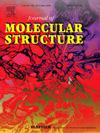利用太赫兹技术研究毫米级金属有机框架单晶的光学特性
IF 4
2区 化学
Q2 CHEMISTRY, PHYSICAL
引用次数: 0
摘要
金属有机框架(MOFs)晶体是很有前途的太赫兹(THz)光子学新兴材料,即通过差频或光学整流和电光探测产生太赫兹波,包括用于太赫兹光束转向的光学元件。本研究报告介绍了三种不同的非中心对称单 MOF 晶体的光学特性,这些晶体是通过创新的溶胶-热技术生长而成的,形态可调,被称为 MOF [Zn(3-ptz)2]n (MIRO-101)。0.25 - 1.5 THz 范围内的 THz 时域光谱 (TTDS) 被用于测量这些 MOF 晶体的传递函数 H(ω)。通过该实验函数 Hexp(ω),计算出折射率 nMOF(ω)和吸收系数 αMOF(ω) 等光学参数,以分析该晶体的光学特性。结果表明,这种 MOF 晶体为创造新型非线性太赫兹光子学材料提供了长期探索特性的机会,可通过不同频率发生(DFG)或光学整流(OR)作为太赫兹辐射发射器,以及通过光学采样进行电光(EO)探测,包括用于光电子学和材料科学。本文章由计算机程序翻译,如有差异,请以英文原文为准。
Optical properties of millimeter-size metal-organic framework single crystals using THz techniques
Metal-organic frameworks (MOFs) crystals are promising emerging materials for terahertz (THz) photonics i.e., for THz wave generation through difference frequency or optical rectification and electrooptic detection, including optical components for THz beam steering. The present work reports optical properties of three different non-centrosymmetric single MOF crystals, grown by an innovative solvo-thermal technique with tunable morphology, termed MOF [Zn(3-ptz)2]n (MIRO-101). THz time-domain spectroscopy (TTDS) in the range of 0.25 – 1.5 THz has been used for the measurement of the transfer function, of these MOF crystals. Through this experimental function , optical parameters such as refractive index, and absorption coefficient have been calculated for the analysis of the optical properties of this crystal. The results indicate that this MOF crystal offers opportunities for long-term exploration of properties toward the creation of novel nonlinear THz photonics materials, as a THz radiation emitter via Different Frequency Generation (DFG) or Optical Rectification (OR) and Electro-optic (EO) detection via optical sampling, including for its use in optoelectronics, and materials science.
求助全文
通过发布文献求助,成功后即可免费获取论文全文。
去求助
来源期刊

Journal of Molecular Structure
化学-物理化学
CiteScore
7.10
自引率
15.80%
发文量
2384
审稿时长
45 days
期刊介绍:
The Journal of Molecular Structure is dedicated to the publication of full-length articles and review papers, providing important new structural information on all types of chemical species including:
• Stable and unstable molecules in all types of environments (vapour, molecular beam, liquid, solution, liquid crystal, solid state, matrix-isolated, surface-absorbed etc.)
• Chemical intermediates
• Molecules in excited states
• Biological molecules
• Polymers.
The methods used may include any combination of spectroscopic and non-spectroscopic techniques, for example:
• Infrared spectroscopy (mid, far, near)
• Raman spectroscopy and non-linear Raman methods (CARS, etc.)
• Electronic absorption spectroscopy
• Optical rotatory dispersion and circular dichroism
• Fluorescence and phosphorescence techniques
• Electron spectroscopies (PES, XPS), EXAFS, etc.
• Microwave spectroscopy
• Electron diffraction
• NMR and ESR spectroscopies
• Mössbauer spectroscopy
• X-ray crystallography
• Charge Density Analyses
• Computational Studies (supplementing experimental methods)
We encourage publications combining theoretical and experimental approaches. The structural insights gained by the studies should be correlated with the properties, activity and/ or reactivity of the molecule under investigation and the relevance of this molecule and its implications should be discussed.
 求助内容:
求助内容: 应助结果提醒方式:
应助结果提醒方式:


